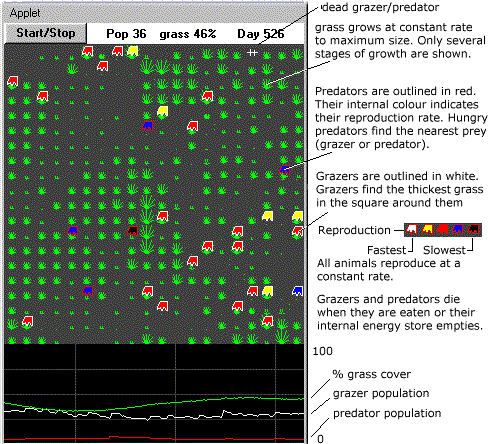The Malthus Simulation model
Although the Malthus model is simple, it has to perform many operations, and may be very slow with some processors. It was developed using a 133 MHz Pentium system.

The Malthus model is a simple simulation. Using data in the applet parameters, some amount of grass is initialised, and some numbers of grazers and predators randomly dispersed in the field. The model then updates one time step after another. At each time step, the grass grows by some amount, and grazers and predators, if hungry, search for grass/grazers to eat. In the pool model, the grass grows at a constant rate to a maximum size. When completely cropped down, the grass immediately begins regrowing. In the stream model, the total energy input to the field is distributed along the right hand field edge, with the stream flowing from right to left.
Grazers have a constant metabolic rate, and an additional reproduction power expenditure, which determine their basic energy consumption. Grazers get hungry when their internal energy store falls below a trigger level, and at that point they look at the grass in the squares adjacent to them, and move to the square with the thickest grass, and eat as much as they can. Movement and eating have an energy cost. No energy losses from inefficiency are assumed.
Grazers make no attempt to avoid predators. Predators are the same as grazers, except that they have different reproduction rates. When predators get hungry, they locate the nearest prey and move towards it at one square per time step. The distance of the prey is weighted against predators and in favour of dead animals, since it is assumed that predator attacks on predators are very energy-expensive, and carrion feeding is inexpensive ( since the prey is already dead). Predators consume not only the energy fuel store of their prey, but also the energy of reproduction embodied in their prey.
When either predators or grazers die, their remains rot for a while before disappearing. This allows predators to feed off dead grazers for a while if there has been a grazer population crash. Grazers and predators only die of starvation (empty energy stores) or by predation. They do not age or have a natural lifespan.
Grazers and predators expend a constant amount of energy per unit time towards building a replica of themselves. If a starvation level is set, reprodction energy expenditure is zero while their energy store is less than the starvation level. All the characteristics of the parent grazer are inherited by the offspring. If some degree of variation is allowed, reproduction rates may increase or decrease by some step amount from mother to daughter. When a new grazer has been completed, it starts an independent existence. Predator offspring flee from their mother at birth, to avoid being caught and eaten, and also to help disperse predators.
The overall display is partly scalable. With V.1.0 the size of
the applet is usually 300 wide by 400 high. But any variant with
height 100 greater than width should work.
The display shows the field or stream, day by day. The rolling
graph display below shows the levels of several selected variables for
the past 300 days (if the display width is 300 pixels) on a scale
of 0 to 100. Current values appear at the right hand edge.
The graphic display has grey horizontal lines at 25 intervals,
and vertical lines every 100 days.
Clicking on the field brings up a box showing
nearest grazer parameters. Clicking again removes the box.
Clicking on the rolling graph area brings up a box show display
variables. Clicking again removes the box.
Applet Parameters: